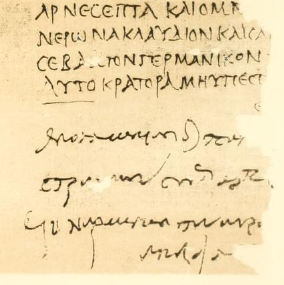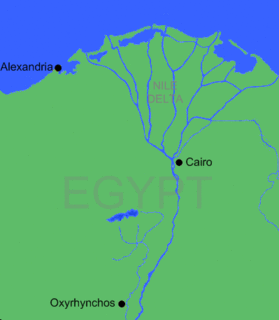Papyrus Oxyrhynchus 44 is a "sale of taxes," from Paniscus to Asclepiades, written in Greek. It was discovered by Grenfell and Hunt in 1897 in Oxyrhynchus. The document was written between the years 66 and 70, although Grenfell and Hunt dated it to the end of the first century. It is housed in the British Museum (749) in London. The text was published by Grenfell and Hunt in 1898.
Papyrus Oxyrhynchus 67 contains three letters about a dispute concerning property, written in Greek. The manuscript was written on papyrus in the form of a sheet. It was discovered by Grenfell and Hunt in 1897 in Oxyrhynchus. The document was written on 28 March 338. Currently it is housed in the British Museum (754) in London. The text was published by Grenfell and Hunt in 1898.
Papyrus Oxyrhynchus 70 is a petition, written in Greek. The manuscript was written on papyrus in the form of a sheet. It was discovered by Grenfell and Hunt in 1897 in Oxyrhynchus. The document was written between 212 and 213. Currently it is housed in the Bolton Art Gallery and Museum in Bolton. The text was published by Grenfell and Hunt in 1898.
Papyrus Oxyrhynchus 73, is a notice of a transfer of property (ἀπογραφή), like P. Oxy. 72. However in this case the property being transferred is a slave. The document is written in Greek. The manuscript was written on papyrus in the form of a sheet. It was discovered by Grenfell and Hunt in 1897 in Oxyrhynchus. The document was written between 25 July and 28 August 94. Currently it is housed in the John Rylands University Library in Manchester. The text was published by Grenfell and Hunt in 1898.
Papyrus Oxyrhynchus 99 concerns the sale of half a house, written in Greek. It was discovered in Oxyrhynchus. The manuscript was written on papyrus in the form of a sheet The document was written on 4 September 55. Currently it is housed at the British Museum (756) in London.
Papyrus Oxyrhynchus 117 is a personal letter, written in Greek and discovered in Oxyrhynchus. The manuscript was written on papyrus in the form of a sheet. The document was written in the 2nd or 3rd century. Currently it is housed in the Haskell Oriental Institute (2066) at the University of Chicago.

Papyrus Oxyrhynchus 246 is a fragment of a registration of some sheep, written in Greek. It was discovered in Oxyrhynchus. The manuscript was written on papyrus in the form of a sheet. It is dated to 24 July 66. Currently it is housed in the Cambridge University Library in Cambridge.
Papyrus Oxyrhynchus 263 is a fragment of a Sale of a Slave, in Greek. It was discovered in Oxyrhynchus. The manuscript was written on papyrus in the form of a sheet. It is dated to 21 April 77. Currently it is housed in the University of Melbourne in Melbourne.
Papyrus Oxyrhynchus 264 is a fragment of a Sale of a Loom, in Greek. It was discovered in Oxyrhynchus. The manuscript was written on papyrus in the form of a sheet. It is dated to 8 August 54. Currently it is housed in the Cambridge University Library in Cambridge.
Papyrus Oxyrhynchus 267 is a fragment of an Agreement of Marriage, in Greek. It was discovered in Oxyrhynchus. The manuscript was written on papyrus in the form of a sheet. It is dated to 22 May 37. Currently it is housed in the Milton S. Eisenhower Library of the Johns Hopkins University in Baltimore.
Papyrus Oxyrhynchus 269 is a fragment of a Loan of Money, in Greek. It was discovered in Oxyrhynchus. The manuscript was written on papyrus in the form of a sheet. It is dated to 13 May 57. Currently it is housed in the University of Pennsylvania in Philadelphia.
Papyrus Oxyrhynchus 270 is a fragment of an Indemnification of a Surety, in Greek. It was discovered in Oxyrhynchus. The manuscript was written on papyrus in the form of a sheet. It is dated between 26 January - 24 February 94. Currently it is housed in the British Library in London.
Papyrus Oxyrhynchus 272 is a fragment of a Transfer of a Debt, in Greek. It was discovered in Oxyrhynchus. The manuscript was written on papyrus in the form of a sheet. It was written after 10 May 66. Previously it was held in Michigan. Currently the place of its housing is unknown.
Papyrus Oxyrhynchus 275 is a fragment of a Contract of Apprenticeship, in Greek. It was discovered in Oxyrhynchus. The manuscript was written on papyrus in the form of a sheet. It is dated to 18 September 66. Currently it is housed in the British Library in London.
Papyrus Oxyrhynchus 277 is a fragment of a Lease of Land, in Greek. It was discovered in Oxyrhynchus. The manuscript was written on papyrus in the form of a sheet. It is dated to 6 September 19 BC. Currently it is housed in the British Library in London.
Papyrus Oxyrhynchus 280 is a fragment of a Lease of Land, in Greek. It was discovered in Oxyrhynchus. The manuscript was written on papyrus in the form of a sheet. It is dated between years 88-89. Currently it is housed in the Cambridge University Library in Cambridge.
Papyrus Oxyrhynchus 288 is a fragment of a Taxation Account, in Greek. It was discovered in Oxyrhynchus. The manuscript was written on papyrus in the form of a sheet. It was written after 22 July 25. Currently it is housed in the British Library in London.
Papyrus Oxyrhynchus 293 is a fragment of a Letter to a Sister, in Greek. It was discovered in Oxyrhynchus. The manuscript was written on papyrus in the form of a sheet. It was written at 15 November 27. Currently it is housed in the library of the Columbia University in New York City.






